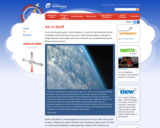
Learn about the properties of air and air pressure
- Subject:
- Physical Science
- Material Type:
- Activity/Lab
- Provider:
- National Air and Space Museum
- Author:
- National Air and Space Museum
- Date Added:
- 09/14/2022

Learn about the properties of air and air pressure

What do falling down an elevator shaft and orbiting Earth have in common? Try these experiments to find out.

Gravity is the main force to be dealt with in space, and thrust is the force that allows a spacecraft to get into space and maneuver.

In this fast-paced NASA Brain Bites_íěÖ video, an astronaut demonstrates the impact of microgravity on the use of tools in space.
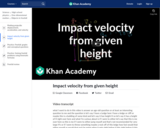
Determining how fast something will be traveling upon impact when it is released from a given height. Created by Sal Khan.
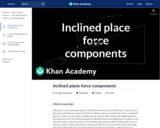
Figuring out the components of the force due to gravity that are parallel and perpendicular to the surface of an inclined plane. Created by Sal Khan.
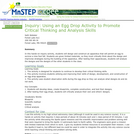
In this hands-on inquiry activity, students will design and construct an apparatus that will permit an egg to survive a nine foot fall. Students are given limited materials, so they must critically think about the design and improvise strategies during the building of the apparatus
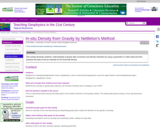
This lab exercise involves small teams of 3-4 students working to collect a profile of gravity measurements over a topographic feature. There is a slope break on our campus where this exercise is done, but any fairly prominent topographic feature will suffice. The students make several measurements with the gravimeter, and collect their own topographic data using meter-tapes and hand-levels although a GPS unit could also be used. The students then convert the meter readings into relative gravity measurements, and make graphs using several different assumed densities. This exercise gives the students practice in collecting field data, analyzing numerically and graphically, and understanding theoretical concepts.
(Note: this resource was added to OER Commons as part of a batch upload of over 2,200 records. If you notice an issue with the quality of the metadata, please let us know by using the 'report' button and we will flag it for consideration.)

This is an activity about orbital mechanics. Learners will investigate how lateral velocity affects the orbit of a spacecraft such as the ISS. Mathematical extensions are provided. This is science activity 1 of 2 found in the ISS L.A.B.S. Educator Resource Guide.
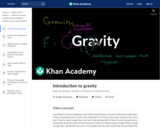
Basics of gravity and the Law of Universal Gravitation. Created by Sal Khan.

This text includes 25 reading assignments for an introductory astronomy course. They have been modified from the OpenStax Astronomy 2e and College Physics 2e (linked in related resources below) textbooks to order the topics in a logical manner for a one semester course and provide shortened (~10-20 pages) readings intended for biweekly reading assignments. The text also features enhanced treatment of the Newton's Laws, Energy, and Optics content that go beyond the typical introductory astronomy course for non-majors.
Course connections: This content was built for an introductory survey of astronomy course (e.g., PHYS 103), including apparent motions of objects in the sky, light, telescopes, solar system objects, exoplanets, the sun, stars, galaxies, and cosmology. Basic math skills (arithmetic, powers, scientific notation, unit conversions) will be used frequently. This course is designed for students in all majors.

This animation from KET's distance learning physics course demonstrates the mathematical formula for a scientific law as it applies to light.
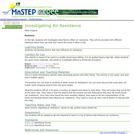
Students investigate air resistance using many objects. No formal lab procedure, just a few simple instructions leaves a guided-inquiry lab activity.
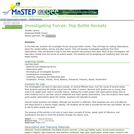
This activity is a field investigation where students will gather data on speed, acceleration, gravity, friction, and forces. They will design and conduct an investigation.
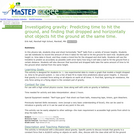
This physics activity is a projectile motion / gravity investigation where students drop and shoot (horizontally) soft balls from different heights and record the time taken to hit the ground. Students make a trendline to predict the time it will take the ball to hit the ground from a certain height. Students will also discover that shot and dropped balls hit the ground at the same time.
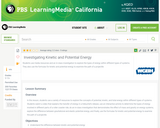
Students use media resources and an in-class investigation to explore the types of energy within different types of systems. They also use the formulas for kinetic and potential energy to examine the path of a projectile.
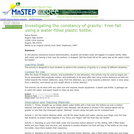
In this physics interactive lecture demonstration, students will investigate the effects of acceleration due to gravity in a number of different situations using a plastic water bottle. Based on an original activity from Peter Hopkinson, AAPT.

How do we communicate with each other? How do we communicate with people who are close by? How do we communicate with people who are far away? In this lesson, students will explore the role of communications and how satellites help people communicate with others far away and in remote areas with nothing around (i.e., no obvious telecommunications equipment). Students will learn about how engineers design satellites to benefit life on Earth. This lesson also introduces the theme of the rockets curricular unit.
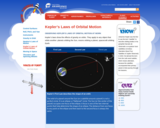
Kepler's laws show the effects of gravity on orbits. They apply to any object that orbits another: planets orbiting the Sun, moons orbiting a planet, spacecraft orbiting Earth.
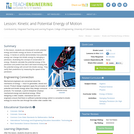
In this lesson, students are introduced to both potential energy and kinetic energy as forms of mechanical energy. A hands-on activity demonstrates how potential energy can change into kinetic energy by swinging a pendulum, illustrating the concept of conservation of energy. Students calculate the potential energy of the pendulum and predict how fast it will travel knowing that the potential energy will convert into kinetic energy. They verify their predictions by measuring the speed of the pendulum.